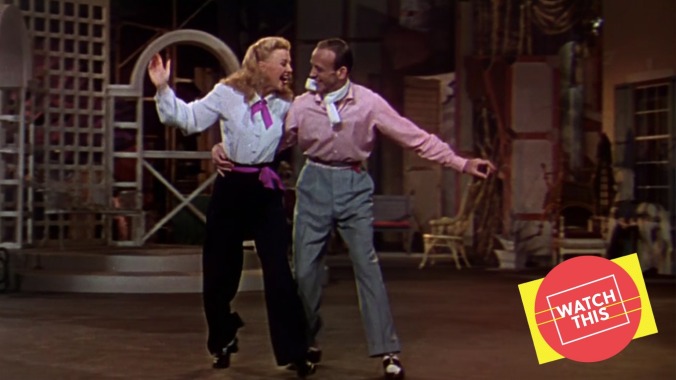
Watch This offers movie recommendations inspired by new releases, premieres, current events, or occasionally just our own inscrutable whims. This week: With Man Of Steel costars Kevin Costner and Diane Lane appearing together again in Let Him Go, we’re looking back at other onscreen star reunions.
The Barkleys Of Broadway (1949)
Throughout the 1930s, Fred Astaire and Ginger Rogers made nine movies together, cementing their status as Hollywood’s most legendary dance team. These elegant black-and-white musicals—often featuring the greatest songs of the age by composers like the Gershwin brothers and Irving Berlin—served as welcome fantasy-filled escapism for a nation grappling with the Great Depression. By the end of the decade, though, the duo understandably aspired to break out: Ginger Rogers left musicals for light comedies and dramatic acting, while Astaire stayed in the genre, dancing alongside the likes of Rita Hayworth, Eleanor Powell, and Judy Garland. That last pairing, in 1948’s Easter Parade, proved so popular that a rematch was scheduled. But Garland’s addiction issues necessitated a recast, and Astaire’s old partner was drafted—10 years after their previous film together.
The original Astaire-Rogers partnership ended on a bit of a downer with 1939’s The Story Of Vernon And Irene Castle, which concludes with tragedy. All of the pair’s other pictures, though, wrapped up with the in-love duo happily dancing off into apparent eternal bliss together. Barkleys offers a kind of next chapter to their usual happily-ever-afters. What would those fantasy romances have looked like 10 years on? Probably a lot like the life of the Barkleys, a.k.a. frequently quarreling Broadway duo Josh and Dinah, successful but itching to see what life looks like outside of their partnership.
Barkleys offers the only view of Fred and Ginger together in real-life Technicolor, but other precedents are even more revealing: We see the pair together in official domesticity for the first time, planning midnight snacks of scrambled eggs and toast, sauntering around in bathrobes, sniping at each other over their his and hers vanities. Dinah, fed up with Josh’s perfectionist tendencies, is intrigued by the chance to star as a serious dramatic actress in a new production by a dashing French playwright (Jacques François). The Barkleys plot mirrors the real-life Astaire-Rogers split quite a bit: Astaire was a known perfectionist, and Rogers’ venture into drama won her the Best Actress Oscar for 1940’s Kitty Foyle. But in previous Astaire-Rogers pictures, the only conflict ever came from Fred trying to win Ginger over. To see the two icons bickering, nearly at each others’ throats at times, is revelatory. It’s actually the only realistic depiction of a relationship in one of their movies: The semblance of an actual marriage materializes against a backdrop of increasingly colorful musical numbers (including a new rendition of the Gershwin classic “They Can’t Take That Away From Me,” a song that Astaire sang to Rogers in 1937’s Shall We Dance).
The Barkleys Of Broadway pulls back the curtain on some other elements of the Astaire-Rogers pairing. One of the things that made the couple so successful is that they made their impossible dance moves, from elegant ballroom to jazzy tap, seem so easy. In the excellent “Bouncing The Blues,” Josh and Dinah are rehearsing a new number for their show. The two aren’t in evening clothes, and they’re “performing” on a cluttered, not yet set-up stage, backed primarily by percussion. It’s a showy tap routine that brings to mind the couple in their prime, but in this close-up view, what’s evident is not just the tremendous skill involved in the pair’s spot-on synchronicity but also their obvious joy in dancing together again. Especially for Rogers, who likely hadn’t been rehearsing dance numbers for years, it’s a master stroke. Astaire chucks her under the chin (in what appears to be an ad-lib), she giggles in response, and their sheer delight is clear. Stripped of their films’ usual setting, spectacle, and plot, what emerges in “Bouncing The Blues”—and throughout Barkleys—is what made Fred and Ginger a dance team like no other: their off-the-charts chemistry, and the unbridled affection they had for each other.
Availability: The Barkleys Of Broadway is available for digital rental or purchase via Amazon, Google Play, Apple, YouTube, Microsoft, Fandango, DirecTV, and VUDU.